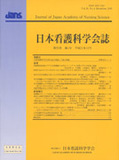Japanese
English
- 販売していません
- Abstract 文献概要
- 参考文献 Reference
要旨
本研究は,気管支喘息をもつ学童が喘息発作による主な症状である「息苦しさ」をどのように体験しているのかを明らかにすることを目的に,民族看護学の研究方法を用いて行った.主要情報提供者である気管支喘息をもつ学童11名への参加観察と面接,一般情報提供者として主要情報提供者の保護者,病棟看護師,救急外来看護師,医師,保育士等の計39名への面接により得られたデータを分析した結果,5つのテーマと1つの大テーマが抽出された.
学童にとって,息苦しさはいきなり外からやって来ると感じられ,息苦しさが「ひどく」なると胸からする「ヒューヒュー」という音が「魂が抜ける音」にも聞こえてくるものであった.そして息苦しさの恐怖の中,学童はひとりで何とかしようともがきながら早く大人に気づいてほしいと待ち続けていることが明らかになった.
以上のことから,看護師は生きることを脅かされる学童の発作体験にも耳を傾けていくことが必要である.また学童の息苦しさの体験は,母親が側にいることで緩和される傾向があったため,看護師がこのことを保護者に伝え,保護者が意識して実践することで,学童の息苦しさの感覚は早期に緩和されるのではないかと示唆された.
Abstract
The purpose of the present study is to identify the experience of pulmonary dyspnea by school-aged children with bronchial asthma. Ethno-nursing methodology has been adopted throughout this research: 11 school-aged children with bronchial asthma participated as main informants and among 39 general informants are main informants' mothers or fathers, nurses working in a pediatric ward or emergency room, doctors, nursery teachers and others. The data were collected using participant observation and interviews. As a result, five sub-themes and one main theme were identified. Briefly put, the main theme includes the following: school-aged children sensed that pulmonary dyspnea was coming from outside; if dyspnea was severe they sensed howling from their chest as their soul went out; they were frightened in severe dyspnea like that;and they were waiting for help from adults (especially from their mother), trying to settle down as soon as possible. These findings suggest that it is imperative for nurses not only to provide treatment for the resumption of their normal breathing, but also to give particular attention to their experience of asthmatic attack, ‘life-threatening’ pulmonary. The children had a tendency to experience less dyspnea if adults (mothers in particular) were nearby. In conclusion, it is suggested that parents' staying nearby after the transmission of this knowledge from nurses to parents might lead to an immediate reduction of the children's pulmonary dyspnea.
Copyright © 2009, Japan Academy of Nursing Science. All rights reserved.


